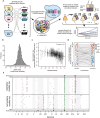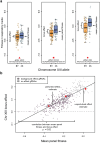This is a preprint.
Global epistasis in budding yeast driven by many natural variants whose effects scale with fitness
- PMID: 40501638
- PMCID: PMC12154726
- DOI: 10.1101/2025.05.28.656710
Global epistasis in budding yeast driven by many natural variants whose effects scale with fitness
Update in
-
Global epistasis in budding yeast driven by many natural variants whose effects scale with fitness.Genetics. 2025 Jul 18:iyaf136. doi: 10.1093/genetics/iyaf136. Online ahead of print. Genetics. 2025. PMID: 40679398
Abstract
Global epistasis is a phenomenon in which the effects of genetic perturbations depend on the fitness of the individuals in which they occur. In populations with natural genetic variation, global epistasis arises from interactions between perturbations and polymorphic loci that are mediated by fitness. To investigate the prevalence and characteristics of loci involved in these interactions in the budding yeast Saccharomyces cerevisiae, we used combinatorial DNA barcode sequencing to measure the fitness of 169 cross progeny (segregants) subjected to 8,126 CRISPRi perturbations across two environments. Global epistasis was evident in these data, with more fit segregants within each environment exhibiting greater sensitivity to genetic perturbations than less fit segregants. We dissected the genetic basis of this global epistasis by scanning the genome for loci whose effects covary with CRISPRi-induced reductions in population fitness. This approach identified 58 loci that interact with fitness, most of which exhibited larger effects in the absence of genetic perturbations. In aggregate, these loci explained the observed global epistasis in each environment and demonstrated that the loci contributing to global epistasis largely overlap with those influencing fitness in unperturbed conditions.
Keywords: background effects; fitness; genetic interactions; genetic perturbations; global epistasis; natural genetic variation.
Conflict of interest statement
Conflict of Interest: None declared.
Figures





Similar articles
-
Global epistasis in budding yeast driven by many natural variants whose effects scale with fitness.Genetics. 2025 Jul 18:iyaf136. doi: 10.1093/genetics/iyaf136. Online ahead of print. Genetics. 2025. PMID: 40679398
-
Epistasis and cryptic QTL identified using modified bulk segregant analysis of copper resistance in budding yeast.Genetics. 2025 Apr 17;229(4):iyaf026. doi: 10.1093/genetics/iyaf026. Genetics. 2025. PMID: 39989051
-
The effect of sample site and collection procedure on identification of SARS-CoV-2 infection.Cochrane Database Syst Rev. 2024 Dec 16;12(12):CD014780. doi: 10.1002/14651858.CD014780. Cochrane Database Syst Rev. 2024. PMID: 39679851 Free PMC article.
-
Sexual Harassment and Prevention Training.2024 Mar 29. In: StatPearls [Internet]. Treasure Island (FL): StatPearls Publishing; 2025 Jan–. 2024 Mar 29. In: StatPearls [Internet]. Treasure Island (FL): StatPearls Publishing; 2025 Jan–. PMID: 36508513 Free Books & Documents.
-
Behavioral interventions to reduce risk for sexual transmission of HIV among men who have sex with men.Cochrane Database Syst Rev. 2008 Jul 16;(3):CD001230. doi: 10.1002/14651858.CD001230.pub2. Cochrane Database Syst Rev. 2008. PMID: 18646068
References
-
- Bachmann M. 2024. rapidfuzz/RapidFuzz: Release 3.8.1. doi: 10.5281/zenodo.10938887. [accessed 2025 Jan 25]. https://zenodo.org/records/10938887. - DOI
-
- Barter R, Yu B. 2017. superheat: A Graphical Tool for Exploring Complex Datasets Using Heatmaps. [accessed 2025 Jan 25]. https://cran.r-project.org/web/packages/superheat/index.html.
Publication types
Grants and funding
LinkOut - more resources
Full Text Sources
